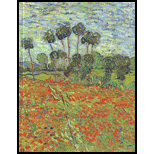
Concept explainers
To explain: Where and when agriculture started in the Fertile Crescent.
Introduction: Agriculture or domestication of plants involves cultivation of selected plant species for food and other requirements by humans.
Explanation of Solution
At least 11 different independent centers have been identified throughout the world where agriculture has been considered to have begun by humans. Out of these, the Fertile Crescent is considered to be the oldest known center of agriculture. The Fertile Crescent is an area in the Near East, which includes the parts of the present day countries of Israel, Iraq, Iran, Jordan, Lebanon, Syria, and Turkey. Studies show that plant domestication began at the Fertile Crescent around 13,000 to 11,000 years ago.
To name: The plants that were important as early crops.
Introduction: Plants that are primarily grown by humans to meet food and other requirements are called crop plants.
Explanation of Solution
Plants that were first brought under cultivation in the Fertile Crescent at the beginning of agriculture included wild barley (Hordeum vulgare subsp) and early forms of wheat (emmer and einkorn wheat) along with peas (Pisum sativum) and lentils (Lens culinaris).
Other plants in the area that were included in cultivation were chickpeas (Cicer arietinum), olives (Olea europaea), Vicia spp., pomegranates (Punica granatum), dates (Phoenix dactylifera), and grapes (Vitis vinifera). Grapes and barley were used from a very early time for brewing wine and beer respectively.
Flax (Linum usitatissimum) was also included in cultivated crops from very early times, most probably both as a source of fiber for cloth and food. Studies have also indicated cultivation of figs in the Jordan Valley, about 11,400 to 11,200 years ago. Thus, legumes along with cereals, were among the important plants that were first cultivated during the beginnings of agriculture in different parts of the world.
Other regions where agriculture began, such as Yellow river regions of China began cultivation of millets, rice, and soybeans. In parts of tropical and subtropical Asia, Africa, Hawaii, and New Guinea, early crops included root crops, various legumes, mango, citrus fruits, taro (Colocasia esculenta), Xanthosoma, bananas, sugarcane, yam, sorghum, vegetables, and cotton. Coffee cultivation originated from Africa, and it became a commercially important crop later in the early era.
Want to see more full solutions like this?
- Give examples of fat soluble and non-fat soluble hormonesarrow_forwardJust click view full document and register so you can see the whole document. how do i access this. following from the previous question; https://www.bartleby.com/questions-and-answers/hi-hi-with-this-unit-assessment-psy4406-tp4-report-assessment-material-case-stydu-ms-alecia-moore.-o/5e09906a-5101-4297-a8f7-49449b0bb5a7. on Google this image comes up and i have signed/ payed for the service and unable to access the full document. are you able to copy and past to this response. please see the screenshot from google page. unfortunality its not allowing me attch the image can you please show me the mathmetic calculation/ workout for the reult sectionarrow_forwardIn tabular form, differentiate between reversible and irreversible cell injury.arrow_forward
- 1.)What cross will result in half homozygous dominant offspring and half heterozygous offspring? 2.) What cross will result in all heterozygous offspring?arrow_forward1.Steroids like testosterone and estrogen are nonpolar and large (~18 carbons). Steroids diffuse through membranes without transporters. Compare and contrast the remaining substances and circle the three substances that can diffuse through a membrane the fastest, without a transporter. Put a square around the other substance that can also diffuse through a membrane (1000x slower but also without a transporter). Molecule Steroid H+ CO₂ Glucose (C6H12O6) H₂O Na+ N₂ Size (Small/Big) Big Nonpolar/Polar/ Nonpolar lonizedarrow_forwardwhat are the answer from the bookarrow_forward
- what is lung cancer why plants removes liquid water intead water vapoursarrow_forward*Example 2: Tracing the path of an autosomal dominant trait Trait: Neurofibromatosis Forms of the trait: The dominant form is neurofibromatosis, caused by the production of an abnormal form of the protein neurofibromin. Affected individuals show spots of abnormal skin pigmentation and non-cancerous tumors that can interfere with the nervous system and cause blindness. Some tumors can convert to a cancerous form. i The recessive form is a normal protein - in other words, no neurofibromatosis.moovi A typical pedigree for a family that carries neurofibromatosis is shown below. Note that carriers are not indicated with half-colored shapes in this chart. Use the letter "N" to indicate the dominant neurofibromatosis allele, and the letter "n" for the normal allele. Nn nn nn 2 nn Nn A 3 N-arrow_forwardI want to be a super nutrition guy what u guys like recommend mearrow_forward
 Human Anatomy & Physiology (11th Edition)BiologyISBN:9780134580999Author:Elaine N. Marieb, Katja N. HoehnPublisher:PEARSON
Human Anatomy & Physiology (11th Edition)BiologyISBN:9780134580999Author:Elaine N. Marieb, Katja N. HoehnPublisher:PEARSON Biology 2eBiologyISBN:9781947172517Author:Matthew Douglas, Jung Choi, Mary Ann ClarkPublisher:OpenStax
Biology 2eBiologyISBN:9781947172517Author:Matthew Douglas, Jung Choi, Mary Ann ClarkPublisher:OpenStax Anatomy & PhysiologyBiologyISBN:9781259398629Author:McKinley, Michael P., O'loughlin, Valerie Dean, Bidle, Theresa StouterPublisher:Mcgraw Hill Education,
Anatomy & PhysiologyBiologyISBN:9781259398629Author:McKinley, Michael P., O'loughlin, Valerie Dean, Bidle, Theresa StouterPublisher:Mcgraw Hill Education, Molecular Biology of the Cell (Sixth Edition)BiologyISBN:9780815344322Author:Bruce Alberts, Alexander D. Johnson, Julian Lewis, David Morgan, Martin Raff, Keith Roberts, Peter WalterPublisher:W. W. Norton & Company
Molecular Biology of the Cell (Sixth Edition)BiologyISBN:9780815344322Author:Bruce Alberts, Alexander D. Johnson, Julian Lewis, David Morgan, Martin Raff, Keith Roberts, Peter WalterPublisher:W. W. Norton & Company Laboratory Manual For Human Anatomy & PhysiologyBiologyISBN:9781260159363Author:Martin, Terry R., Prentice-craver, CynthiaPublisher:McGraw-Hill Publishing Co.
Laboratory Manual For Human Anatomy & PhysiologyBiologyISBN:9781260159363Author:Martin, Terry R., Prentice-craver, CynthiaPublisher:McGraw-Hill Publishing Co. Inquiry Into Life (16th Edition)BiologyISBN:9781260231700Author:Sylvia S. Mader, Michael WindelspechtPublisher:McGraw Hill Education
Inquiry Into Life (16th Edition)BiologyISBN:9781260231700Author:Sylvia S. Mader, Michael WindelspechtPublisher:McGraw Hill Education





